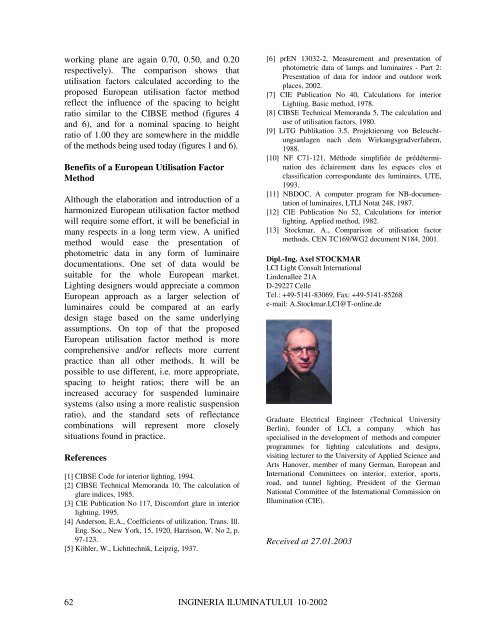european utilisation factor method - Journal of Lighting Engineering
european utilisation factor method - Journal of Lighting Engineering
european utilisation factor method - Journal of Lighting Engineering
You also want an ePaper? Increase the reach of your titles
YUMPU automatically turns print PDFs into web optimized ePapers that Google loves.
working plane are again 0.70, 0.50, and 0.20<br />
respectively). The comparison shows that<br />
<strong>utilisation</strong> <strong>factor</strong>s calculated according to the<br />
proposed European <strong>utilisation</strong> <strong>factor</strong> <strong>method</strong><br />
reflect the influence <strong>of</strong> the spacing to height<br />
ratio similar to the CIBSE <strong>method</strong> (figures 4<br />
and 6), and for a nominal spacing to height<br />
ratio <strong>of</strong> 1.00 they are somewhere in the middle<br />
<strong>of</strong> the <strong>method</strong>s being used today (figures 1 and 6).<br />
Benefits <strong>of</strong> a European Utilisation Factor<br />
Method<br />
Although the elaboration and introduction <strong>of</strong> a<br />
harmonized European <strong>utilisation</strong> <strong>factor</strong> <strong>method</strong><br />
will require some effort, it will be beneficial in<br />
many respects in a long term view. A unified<br />
<strong>method</strong> would ease the presentation <strong>of</strong><br />
photometric data in any form <strong>of</strong> luminaire<br />
documentations. One set <strong>of</strong> data would be<br />
suitable for the whole European market.<br />
<strong>Lighting</strong> designers would appreciate a common<br />
European approach as a larger selection <strong>of</strong><br />
luminaires could be compared at an early<br />
design stage based on the same underlying<br />
assumptions. On top <strong>of</strong> that the proposed<br />
European <strong>utilisation</strong> <strong>factor</strong> <strong>method</strong> is more<br />
comprehensive and/or reflects more current<br />
practice than all other <strong>method</strong>s. It will be<br />
possible to use different, i.e. more appropriate,<br />
spacing to height ratios; there will be an<br />
increased accuracy for suspended luminaire<br />
systems (also using a more realistic suspension<br />
ratio), and the standard sets <strong>of</strong> reflectance<br />
combinations will represent more closely<br />
situations found in practice.<br />
References<br />
[1] CIBSE Code for interior lighting, 1994.<br />
[2] CIBSE Technical Memoranda 10, The calculation <strong>of</strong><br />
glare indices, 1985.<br />
[3] CIE Publication No 117, Discomfort glare in interior<br />
lighting, 1995.<br />
[4] Anderson, E.A., Coefficients <strong>of</strong> utilization, Trans. Ill.<br />
Eng. Soc., New York, 15, 1920, Harrison, W. No 2, p.<br />
97-123.<br />
[5] Köhler, W., Lichttechnik, Leipzig, 1937.<br />
62<br />
INGINERIA ILUMINATULUI 10-2002<br />
[6] prEN 13032-2, Measurement and presentation <strong>of</strong><br />
photometric data <strong>of</strong> lamps and luminaires - Part 2:<br />
Presentation <strong>of</strong> data for indoor and outdoor work<br />
places, 2002.<br />
[7] CIE Publication No 40, Calculations for interior<br />
<strong>Lighting</strong>, Basic <strong>method</strong>, 1978.<br />
[8] CIBSE Technical Memoranda 5, The calculation and<br />
use <strong>of</strong> <strong>utilisation</strong> <strong>factor</strong>s, 1980.<br />
[9] LiTG Publikation 3.5, Projektierung von Beleuchtungsanlagen<br />
nach dem Wirkungsgradverfahren,<br />
1988.<br />
[10] NF C71-121, Méthode simplifiée de prédétermination<br />
des éclairement dans les espaces clos et<br />
classification correspondante des luminaires, UTE,<br />
1993.<br />
[11] NBDOC, A computer program for NB-documentation<br />
<strong>of</strong> luminaires, LTLI Notat 248, 1987.<br />
[12] CIE Publication No 52, Calculations for interior<br />
lighting, Applied <strong>method</strong>, 1982.<br />
[13] Stockmar, A., Comparison <strong>of</strong> <strong>utilisation</strong> <strong>factor</strong><br />
<strong>method</strong>s, CEN TC169/WG2 document N184, 2001.<br />
Dipl.-Ing. Axel STOCKMAR<br />
LCI Light Consult International<br />
Lindenallee 21A<br />
D-29227 Celle<br />
Tel.: +49-5141-83069, Fax: +49-5141-85268<br />
e-mail: A.Stockmar.LCI@T-online.de<br />
Graduate Electrical Engineer (Technical University<br />
Berlin), founder <strong>of</strong> LCI, a company which has<br />
specialised in the development <strong>of</strong> <strong>method</strong>s and computer<br />
programmes for lighting calculations and designs,<br />
visiting lecturer to the University <strong>of</strong> Applied Science and<br />
Arts Hanover, member <strong>of</strong> many German, European and<br />
International Committees on interior, exterior, sports,<br />
road, and tunnel lighting, President <strong>of</strong> the German<br />
National Committee <strong>of</strong> the International Commission on<br />
Illumination (CIE).<br />
Received at 27.01.2003
















